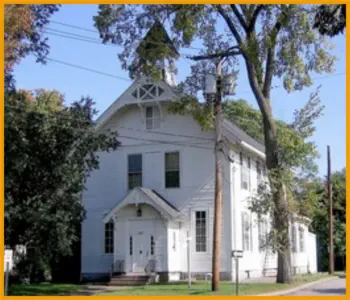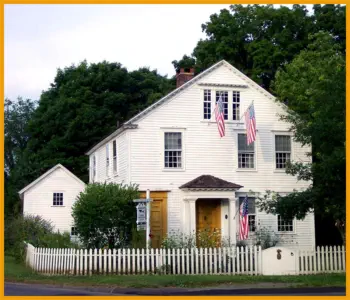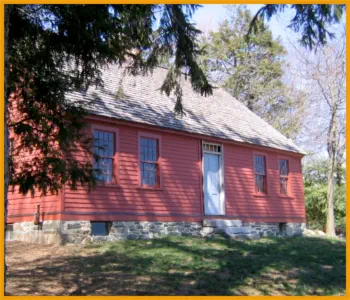



Orange Historical Society


Orange, Connecticut
About Our Town
Col.
Asa
Platt
House
—
2
Tyler
City
Road
(added
2002).
Federal
style.
Built
in
1810,
it
is
thought
to
have
been
built
by
David
Hoadley
,
who
built
the
Orange
Congregational
Church.
The
nomination
to
the
register,
by
Jan
Cunningham,
refers
to
"the
elegant
refinement
of
the
interior",
repeated
elliptical
forms
in
"the
sunbursts
of
the
mantelpieces;
in
the
recessed
panels
below
the
parlor
windows;
in
the
capitals
of
the
arches;
and,
in
a
wholly
unexpected
manner,
in
the
high
relief
of
the
egg
form
that
embellishes
the
simple
mantel
frieze
in
a second-floor chamber."
Henry
F.
Miller
House
—
30
Derby
Ave.
(added
May
25,
2001).
This
international
style
house
was
completed
in
1949
and
featured
at
the
time in the New Haven Register as "The House of Tomorrow".
Orange
Center
Historic
District
—
Roughly
Orange
Center
Road
from
Orange
Cemetery
to
Nan
Drive
(added
August
10,
1989).
The
district
was
originally
established
by
the
town
January
13,
1978.
The
Orange
Congregational
Church,
designed
by
David
Hoadley
and
built
in
1810
on
the
town
green,
is
a
centerpiece
of
the
district.
This
Federal
style
church
features
a
Palladian
window,
domed
belfry
and
a painted black oval "window" on the front tower.
The
district
also
includes
the
Stone-Otis
House
(Federal
with
Greek
revival
portico),
built
circa
1830
(now
a
museum)
and
The
Academy,
a schoolhouse built in 1878 with
Stick style
elements, including an elaborate gable screen, also now a museum.
William
Andrew
House
(also
known
as
Bryan-Andrew
House
)
—
131
Old
Tavern
Road
(added
2002).
Built
about
1750
for
the
Bryan
family,
early
settlers
in
North
Milford.
This
area
was
known
as
"Bryan's
Farms".
The
house
includes
a
finely
detailed
front
cornice,
feather-edged
sheathing
and
hand-split
lath
laboriously
installed
without
nails.
The
house
later
served
as
housing
for
dairy
farm
employees and was ultimately bought by the Town of Orange in 2000 to be restored for use as a museum.












Bryan Andrew





About Our Town
Col.
Asa
Platt
House
—
2
Tyler
City
Road
(added
2002).
Federal
style.
Built
in
1810,
it
is
thought
to
have
been
built
by
David
Hoadley
,
who
built
the
Orange
Congregational
Church.
The
nomination
to
the
register,
by
Jan
Cunningham,
refers
to
"the
elegant
refinement
of
the
interior",
repeated
elliptical
forms
in
"the
sunbursts
of
the
mantelpieces;
in
the
recessed
panels
below
the
parlor
windows;
in
the
capitals
of
the
arches;
and,
in
a
wholly
unexpected
manner,
in
the
high
relief
of
the
egg
form
that
embellishes
the
simple mantel frieze in a second-floor chamber."
Henry
F.
Miller
House
—
30
Derby
Ave.
(added
May
25,
2001).
This
international
style
house
was
completed
in
1949
and
featured
at
the
time
in
the
New Haven Register as "The House of Tomorrow".
Orange
Center
Historic
District
—
Roughly
Orange
Center
Road
from
Orange
Cemetery
to
Nan
Drive
(added
August
10,
1989).
The
district
was
originally
established
by
the
town
January
13,
1978.
The
Orange
Congregational
Church,
designed
by
David
Hoadley
and
built
in
1810
on
the
town
green,
is
a
centerpiece
of
the
district.
This
Federal
style
church
features
a
Palladian
window,
domed
belfry
and
a
painted
black
oval "window" on the front tower.
The
district
also
includes
the
Stone-Otis
House
(Federal
with
Greek
revival
portico),
built
circa
1830
(now
a
museum)
and
The
Academy,
a
schoolhouse
built
in
1878
with
Stick
style
elements,
including
an
elaborate gable screen, also now a museum.
William
Andrew
House
(also
known
as
Bryan-
Andrew
House
)
—
131
Old
Tavern
Road
(added
2002).
Built
about
1750
for
the
Bryan
family,
early
settlers
in
North
Milford.
This
area
was
known
as
"Bryan's
Farms".
The
house
includes
a
finely
detailed
front
cornice,
feather-edged
sheathing
and
hand-split
lath
laboriously
installed
without
nails.
The
house
later
served
as
housing
for
dairy
farm
employees
and
was
ultimately
bought
by
the
Town
of
Orange
in
2000
to be restored for use as a museum.

Orange Historical Society
Orange, Connecticut








Bryan Andrew

























































































